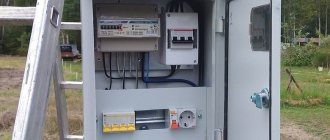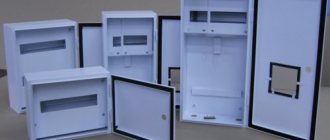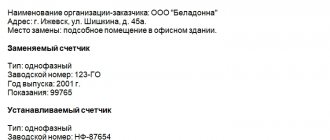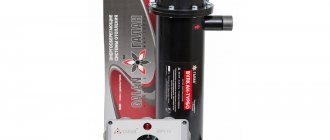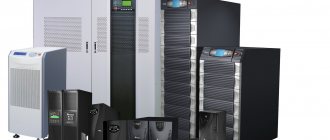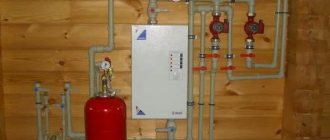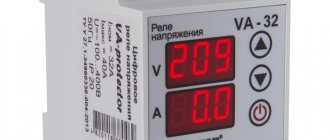Nowadays, we cannot do without a high-quality and well-thought-out power supply system. If, when purchasing an apartment, this problem is solved not by the owner of the property, but by a construction company, then there is a choice for supplying electricity to a private home. The apartment has already been supplied with single-phase power, and this voltage is quite sufficient there. However, in the private sector, a three-phase network may be quite relevant. In this article we will tell you which electrical network is better: three-phase or single-phase, as well as how to supply 380 Volts to a private house according to the law and what documents are needed for this.
Why are “three phases” needed?
This is a really good question.
Generally speaking, not that many electricity consumers that can be used in a private home require a voltage of 380V.
If you don’t get into all sorts of exotic things, then this list might look like this:
- electric heating boiler power from (approximately) 9 kW and above
- deep well water pump
- electric sauna stove with a power of (approximately) 5 kW
- semi-professional equipment for the workshop (lathe or milling machine, good circular saw)
In principle, all of the above can be found in the 220V version. However, 380V will be better - more powerful, simpler, more reliable, more economical.
So, if you are not planning any of the above in your house, then, apparently, you do not need 380V.
Well, if you still decide to choose three phases based on considerations in case it comes in handy in the future, then it is worth keeping in mind one important circumstance - the power supplied to the house is divided evenly between the three phases. And if one of the phases is overloaded relative to the others, a phenomenon called “phase imbalance” occurs. The consequence may be the failure of electrical appliances connected to the home network
To avoid this, it is necessary to load each phase evenly
The consequence may be the failure of electrical appliances connected to the home network. To avoid this, it is necessary to load each phase evenly.
To make it clearer, consider the 380V connection diagram.
The input here is a common machine for all three phases. Next, two wires – one of the phases and “zero” – go to groups of consumers approximately equal in total power. A consumer that needs three-phase power (in this case, an electric heater in a sauna) is connected to a cable with four wires.
So, if we assume that 15 kW of power is allocated to the house, then it turns out that the power of each of the consumer groups connected through the “phase” plus “zero” pair of the above circuit should be no more than 5 kW. Or even less, if you take into account the presence of a “three-phase” consumer. Otherwise, if one of the phases is overloaded, the input circuit breaker will “knock out” and the electricity will be turned off in the entire house.
Accordingly, having installed three-phase electricity into the house, you will then need to think about how to properly route the cable so that the load on each phase is approximately the same.
The unpleasant circumstance here is that some consumers, for example, a good electric hob or oven, have a power of more than 5 kW. In this case, you need to choose equipment that can be connected to a three-phase line. You will have to run a separate line with a separate machine. And these are additional costs.
Here the question arises: is all this necessary? Maybe it would be easier to limit yourself to 220V?
However, as usual in such cases, you can find positive aspects. If you think through the wiring so that each line has no more than 5 kW, this will improve the electrical safety of the house. Less power on each of the “branches” means less current, less wear on wires and contacts. In general, there is something to think about.
Which circuit breakers to choose for the electrical panel
The main question that affects many users is: how to decide on slot machines? The rated current of the circuit breaker is calculated based on such parameters as the consumer’s load or its power.
For example. The rated power of simultaneously switched on electrical appliances and the lighting network will be 15 kW. There is a formula: P=U×I, where P is power, U is voltage, I is current. If P = 15000 W, then the current strength will be (rounded) 68 A. This means the sum of the rated values of the machines should not exceed 68 A. But it should be remembered that a three-phase network is connected to the switchboard, so the rated amperes must be divided by 3, which will give approximately 23 A. This means that the input circuit breaker should be set to 25 A.
Precedent: FAS declared illegal the refusal of electrical networks to connect 380V
In particular, the Belgorod Department of the FAS made a decision that was positive for the consumer in the case of refusal to connect the applicants to electrical networks with a voltage of 380V.
In this case, the power grid refused the “three phases”, indicating that the Technological Connection Rules (the main regulatory act regulating connection to power grids) do not contain direct permission for the consumer to determine the voltage level himself - 220V or 380V? - with which it is connected to electrical networks.
Both of them belong to the voltage class of 0.4 kV, and, they say, the power grid itself determines which of them to connect a particular object to. In this situation, the applicant can only indicate the electrical power that he wants to connect to the power grid.
The FAS office did not agree with this. The decision was motivated as follows:
... In paragraph 14 of the “Rules for Technological Connection”, the applicant is indeed indicated as an individual who has applied for the technological connection of power receiving devices, the maximum power of which is up to 15 kW inclusive, which are used for household and other needs not related to business activities, and whose power supply is provided from one source...
Those. There really seems to be no separate special mention that the consumer can insist on 380V. But!! The decision further states that, in fact, based on the general requirements of the law, the consumer has such a right.
... Referring solely to paragraph 14 of the “Rules for Technological Connection”, the network organization does not take into account that, firstly, all other paragraphs of the Rules that establish lists of documents and information submitted by other categories of applicants also do not contain a special indication of the voltage class.
This is objectively due to the sufficiency of information about the amount of electrical power requested by the applicant for the connected object, the voltage level of which is its integral electrophysical property, which does not imply or require its special allocation. The obligation for any applicant to indicate the voltage class in his application is established by paragraph 2 of clause 8 of the Rules and the provision of part 1 of article 26 of the Law “On Electric Power Industry”.
Secondly, the network organization incorrectly interprets paragraph 14 of the Rules. It literally follows from the provisions of the norm that the application sent by an applicant - an individual for the purpose of technological connection of power receiving devices, must indicate the following data named in the list, that is, only mandatory information is provided below, and the list itself is not exhaustive. The need to indicate the voltage class of the power grid facility to which the connection is planned follows from other industry standards, is characterized by the will of the applicant and has its own organizational and legal reasons.
In this case, the voltage class is the main qualitative characteristic of the power grid facility closest to the applicant’s land plot, which serves as the main criterion for determining the distance from this power grid facility to the boundaries of the land plot (which affects the amount of technological connection). Consequently, the applicant (regardless of whether he is an individual or not) is required to indicate in the application not only the voltage class of the electrical network facility, but also the corresponding voltage class of the power receiving device.
The electric grid company has no right to arbitrarily restrict the applicant in this, since it follows from the current legislation that the voltage class of the electric grid facility is established as one of the conditions of the agreement on technological connection. ...
By searching, you can find other precedents of decisions in favor of owners who require a 380V voltage connection. However, they concern connection to the infrastructure of network organizations, i.e. network companies. If we are talking about associations of summer residents or gardeners, then the problem is more serious.
Types of three-phase sockets
Depending on the connection diagram used for the device that will be powered from a three-phase outlet, four or five wires need to be connected to it. In rare cases, it can be three or seven pieces - in the first case, when the control circuit and grounding are made separately, and in the second, when enhanced protection is used.
For each of these methods, its own socket is selected, with a certain number of contacts. An exception is the case if only three phases need to be connected to the device, but this happens extremely rarely. Here we take a four-pin plug, one of the contacts on which remains empty. You should not buy three-pin sockets that are available in stores - in fact, they are household ones, designed for 220 volts - phase, neutral and ground. They are similar to three-phase ones, since they can connect loads with a current of up to 32 Amperes.
The dimensions of three-phase sockets are usually quite significant, so these devices are not intended for mounting inside the wall, but are screwed externally onto dowels or a stand made for them.
Four-pin sockets
They are the most common in everyday life and in production, in networks where the neutral wire also serves as a ground wire and is connected to the device body. The socket is a base that is mounted on a wall or stand and then a protective cover is put on it.
The design of the sockets and the location of the terminals may differ, so if you plan to connect several devices to one socket, then it would be a good idea to ask the store which of them are constantly on sale.
When connecting, you need to be careful with the zero - in appearance this contact looks like all the others, but is marked with the corresponding icon on the base of the socket or its cover.
The wires are connected to the contacts using a bolted connection. Since most often the contacts themselves are made of brass, the use of aluminum wires is acceptable. If desired, you can use metal washers to be on the safe side.
Five-pin sockets
They are used in modern electrical circuits, where the protective, grounding zero is connected separately from the working zero, which requires a separate contact on the socket. Although only one wire is added compared to four-pin sockets, five-pin sockets are significantly larger in size. Considering that fairly rigid cables are often connected to them, they must be well secured to the wall.
The design of the box, the location of the terminals and their shape may differ, so it is better to select standard models so that, if necessary, you can freely find a replacement.
When purchasing, it is advisable to pay attention to the method of connecting the wires - if it is a bolt, the tip of which presses the wire to the contact, then over time it may break at the point of attachment. A solution to the problem may be to choose a socket model with other fastening methods or use wire lugs with which the cores are crimped
In general, if you need to use bolt clamps, then nothing bad will happen - you just need to check the contacts more often.
The difference between the shields
In stores you will see a wide range of prices for models of electrical panels that are similar in appearance. You will have a desire to save money and buy a cheaper electrical panel. Thanks to the large number of Chinese manufacturers, the quality of the shield can be very low. To reduce the cost, they use cheaper materials that are unsafe in composition and have fire protection.
When used in an apartment or private house, as a rule, the electrical panel is not exposed to precipitation and temperature changes. When installing an electrical panel in unheated rooms or outdoors, the electrical panel can quickly lose its presentation. If low-quality metal is used, the body will be covered with rust outside and inside. The case will lose its seal, the DIN rail will rust from condensation. Circuit breakers and RCDs cannot be operated in such conditions.
Low-quality plastic can crack due to temperature changes and exposure to the sun, and the seal of the electrical panel is lost. If a low-quality rubber or silicone seal is installed in a sealed IP68 electrical panel, it will lose its elasticity over time. As a result, it will not protect against moisture getting inside.
Electrician's recommendations
You should adhere to the basic rules when working:
- horizontal transitions from the junction box to the sockets or switch are laid at a height of 2.5 m;
- the insertion of veins is carried out only vertically or horizontally;
- connection points should only be located in mounting boxes;
- for underground cable laying, you need to use only a single piece with a strong armor tape;
- The biggest mistake is installing the switch in the zero gap;
- It is forbidden to install electrical wires near a wooden surface, but if this is unavoidable, then an insulating hose or gasket made of asbestos and steel with a thickness of 0.2 - 0.5 mm is used.
Grounding options
Grounding serves to protect a person from the harmful effects of electric current if the voltage is uninterrupted. The bottom line is that when a person touches a damaged section of the circuit, and thereby comes under dangerous voltage, the electric current flows along the path of least resistance. In this case, grounding is performed with the least resistance so that the electric current does not flow through you, but through the grounding system into the ground. But for this, the grounding system must be performed in accordance with the rules.
Ground loop
If the area near your house has enough area for a grounding loop, then it is necessary to perform it. In this case, at least three vertical electrodes, at least 2 m long, are driven into the ground. The distance between them should be no less than their length itself. They must be driven into a trench, the depth of which must be at least 0.5 m.
Using horizontal metal rods, they are connected by welding and brought out to the building, after which they are brought to the input device of the house. After installing the grounding, the current resistance is measured. If it does not correspond, then additional electrodes are driven in until the grounding resistance is brought to the required value.
Advantages and disadvantages of a three-phase power supply system
It is no secret that three-phase power supply to a private home is becoming more and more relevant, and this is connected not only with the voltage level. Let's look at all the advantages of 380 Volts and here is a list of them:
- Connection of the most common asynchronous electric motors with a squirrel-cage rotor in everyday life and in production. When connected to a single-phase circuit, their power, torque, and efficiency are lost. After all, they were originally designed for three phases. The use of such electric machines in a private home may be necessary when installing a grinding, drilling or woodworking machine and other types of equipment. An owner who has the skills to operate such equipment will always find a use for it. A powerful pump is always useful at the dacha, so running 380 Volts won’t hurt here either.
- By connecting three phases, the owner of a private house receives, by and large, three independent single-phase networks at once, which he can dispose of at his own discretion. To do this, in order to obtain a single-phase voltage of 220 Volts, you need to connect one wire to the phase and the other to zero. It will be called phase. The voltage between two phases is 380 Volts and is called linear. You can read more about phase and line voltage in the article: https://samelectrik.ru/linejnoe-i-faznoe-napryazhenie.html.
- In the event of a breakdown or emergency at a distribution substation, one or even two phases may burn out. At the same time, the owner of a private house with three phases will at least have lighting and a refrigerator working. It must be remembered that for three-phase motors, operation on two phases will entail its inevitable failure.
Keep in mind that there are pitfalls here too. A three-phase network is needed if the power of a single-phase network is not enough. And even if single-phase is not enough, there is no need to rush to connect three phases, it is better to clarify the possibility of increasing the power limit for a single-phase network - this procedure is much simpler than coordinating and connecting three phases.
Three phases must be connected if it is necessary to power three-phase electric motors that cannot operate in single-phase mode, or if a large number of electrical appliances and equipment are used simultaneously, for example, if the house has a large household or some small-scale production has been established.
Several other disadvantages of the three-phase power supply system should also be noted. One of the disadvantages is the need to distribute loads evenly across each phase. The second drawback is the great difficulty in connecting, purchasing another shield, protective devices, etc. The third drawback is a great danger from the point of view of electric shock, since the house will have not only a single-phase voltage of 220 V, but also a linear voltage of 380 V
As you can see, the advantages of powering the consumer from a 380 Volt network are not always obvious. Now it’s worth figuring out what documents are needed to connect a three-phase network. This is what we will talk about now.
Electrical supply diagram for a private house 380V 15 kW
One of the most important stages in the construction or renovation of a country house is its electrification. In modern housing, a large number of household appliances and all kinds of equipment are installed, and all these devices consume electricity. Therefore, we have to solve such an important issue as connecting the facility to the power grid. To do this, first of all, you will need a 380V, 15 kW power supply circuit for a private house, which can be of two types - single-phase and three-phase. Both options are in demand, but recently preference has been given to a three-phase circuit, which significantly reduces the load on the network due to its even distribution in the form of three parallel lines.
How to properly lay wires on the site
The work is carried out in several stages, each of which should be divided into several steps.
According to regulatory documentation, you will be responsible for the part of the branch that will go to your home.
In most cases, the branch is a nearby power line support, from where the cable can be brought either by air or underground. What you have to do:
- Place a support on your site
if the distance to the overhead line is more than 25 meters. - Bring it
to the support pole
and tighten the electrical cable
. - Purchase
3-phase two-tariff
meter, automatic machines, voltage stabilizers
and connect it all.
When connecting one phase, you will also have to buy a copper cable to go with the aluminum cable. A wire with copper conductors will be needed to run it through the wall into the house, especially if the house is wooden, then according to the PEU, running an aluminum cable through the wall is prohibited
.
According to the rules and regulations, a single-phase branch is carried out by two conductors - this is a phase and a zero, with a strictly insulated wire - a cross-section of at least 16 sq. mm. The optimal solution would be to use SIP-4 aluminum cable.
The cable's service life is 25 years, thanks to the light-repellent polyethylene sheath sewn into the insulation and resistant to the damaging effects of ultraviolet rays. This cable is suitable for 220V power supply.
There is a good option with flame retardant braiding - this is VVG ng
, where the abbreviation
“ng”
means not lit.
This cable is good for any choice of wiring; you can enclose it in a corrugated pipe. When a new wooden house is built
and wiring is laid,
all places where the wiring passes through the walls
are drilled with a drill, then
metal tubes are inserted
.
This must be done, as the house will settle over time.
Additional protection is provided using automatic (AZ)
. It must be installed at the location where the cable breaks; this may be located on the outside of the home. The circuit breaker is selected with a rating one step higher than that of the input circuit breaker in the house, so that in case of overload, the protection in the panel is the first to operate.
Why do apartments have 220 and not 380 volts with 3 phases?
We hope our information does not shock you too much. The fact is that there is no 380 volt input, which means there is no question of how to connect it either.
You didn't believe it? Then let’s explain - there is a 4-wire input (3-phase) and there is a single-phase input (2-wire). But! By providing a 380 volt and 3 phase connection in a private home. What will you get? That's right - three independent pairs of 220V each. Confused?
Let's get some physics of electricity. We are not claiming a Nobel Prize, we will try to present TOE, in a household application, so to speak, from the point of view of aspects of alternating current. Although we cannot do without line voltage.
So, in simple words: linear voltage is a line, as the name suggests, while alternating voltage is a “rotation”, that is, a circle.
The relationship between a line and a circle can be established using trigonometric relationships. Despite the fact that stress has nothing to do with geometry, all dependencies are well reflected by trigonometric formulas.
The easiest way to rotate a circle is to push it at three points. located at an angle of 120 degrees, hence the three phases. As well as the dependence of the length of the line on the circumference, which (roughly) is the square root of 3 (updated, the root of Pi was incorrect, the square root of 3 is correct), that is, approximately 1.73. In other words, with a three-phase network of 220 volts, we will get 127 volts from the consumer, and with 380, the consumer will have 220 volts. Other voltage standards (GOST) also obey this rule. It is for this reason that the use of trigonometric formulas in electrical engineering has become commonplace.
Now let's return to the subtitle, but first a little more theory. Initially, the generation produces three phase wires (under voltage) and a fourth - a neutral wire, common to all three (analogous to the plus and minus in a battery). Voltages can be high because the higher the voltage, the lower the energy transmission losses.
To reduce voltage, transformer substations are used, which are distributed to the population. How many? That's right - 380 volts, 3 phases and those who are powered this way no longer have problems.
List of sources
- www.asutpp.ru
- electricremont.ru
- samelectrik.ru
- subscribe.ru
- electrobox.su
- electriced.ru
- electricalnet.ru
- csgoshik.ru
- Proekt-sam.ru
- ProFazu.ru
The distribution board diagram includes the following components:
A residual current device (RCD) is a device that monitors leakage current in the electrical network. This device opens the contacts if the differential current value (i.e., the difference in current between the phase and neutral conductors) exceeds a critical level. The RCD includes elements designed to measure and compare currents passing through the electrical network and to open the circuit.
The residual current device is designed to prevent fires caused by worn-out wiring and to protect people from electric shock. It can only be installed together with a circuit breaker.
Residual current devices are characterized by the number of poles (2, 4), leakage current (from electric shock - 30 mA), as well as the rated load current. All characteristics are indicated on the inside of the device.
A little about 127, 220, 380 volts and more.
The question is, why can such voltages be found quite often in the network? This issue is worthy of separate scientific research. But we are more interested in the question, we were convinced that 380 volts is better, how to connect? Pretty simple when it comes to wires:
Let's start with the fact that any connection of a private house to the power grid is a matter of coordination with power engineers, and at the first stage you will have to agree on:
- Allowable power;
- Number of phases (i.e. 220 or 380 volts);
- Type of input line and energy meter (below a comment on why there will be no question about how to choose a device);
- Metering tariff (this will depend on the stage of registration of a private home and the number of tariffs that the meter takes into account - by default it is day and night);
- Connection diagram depending on the quality of insulation of the house electrical network;
- Reliability of grounding of the electrical network of your home. We have already written about how to do grounding correctly.
It is most correct to handle the requirement to the maximum - from the requested power (at least 15 kW, up to three-phase input). Further, depending on the price of the issue and local conditions, the requirements can be reduced.
Now to the issue of stress. 127 volts is the safest
voltage, which at a standard current strength does not kill, but only “shakes” the victim well. To reduce the current in such networks, thicker wires are used. Another advantage is the ability to remove 127 volts from two-phase generation at 220 volts.
This is roughly how the energy sector in some countries works, but this is a separate topic. And if we talk about numbers, then this is the same trigonometry that was mentioned above:
220 volts is the borderline “safe” voltage at standard currents, which is why it is accepted as a standard.
We hope you understand what the main disadvantage of the 380 volt network is. which they didn’t really know how to connect, but they installed clean 3 phases. Electric shock in such a network can kill, even with circuit breakers. Hence the required security measures.
What elements does an electrical panel consist of?
It is necessary to purchase the components of the electrical panel immediately, so as not to subsequently waste time and not travel to the electrical store several times a day. The power of the shield is determined, it is 15 kW, which means that the maximum power consumption will not exceed 15 kW/h.
Electrical panel of a private house, list of elements:
- Electric energy meter. The meter is the first element that must be installed in the panel. The best solution would be to purchase an electronic device designed to connect three phases. Such measuring instruments have high accuracy and a long service life. All information is displayed on a digital screen. Electronic meters can be programmed to operate in several tariffs.
- Electrical shield. Now in stores there are a large number of electrical panels of various sizes and designed for a certain number of elements. The price of the product varies depending on the presence of a DIN rail, a built-in lock, as well as an inspection window (especially for taking readings from the meter). You should pay attention to protection from dust and moisture, its level should be at least IP 54. Dimensions - 445 × 400 × 150, and a wall thickness of 1 mm.
- Input circuit breaker. You should purchase a three-pole machine, because the voltage supplied to the house will be 380 V, which means the presence of three phases.
- Residual current device (RCD). It is required to be installed, since it is a protective element when a dangerous potential appears on the body of an electrical device.
- Circuit breakers. The amperage should be selected based on the consumer load, which will be discussed below.
- Voltage relay. Protects household electrical appliances from power surges. Many users install a relay, but it is not a required element. Also now widely used is the surge protection device (SPD). For example, when lightning strikes an overhead power line, the voltage in the house will reach high limits, which will be destructive for all equipment. The SPD will turn off the network in time, but, like the voltage relay, it is not installed often.
- Measuring instruments. They are also an optional element of the electrical panel. Measuring instruments include ammeters and voltmeters, often combined into one product.
Three-phase connection
First of all, you need to prepare all the necessary documentation. It includes technical operating conditions that are issued by the organization that supplies electricity. Based on the technical conditions, design documentation for the electrical supply of the facility is drawn up.
You will need the following documents:
- Agreement with the energy supply organization.
- Inspection report of existing electrical equipment.
- Conclusion of a laboratory study of a circuit designed for a specific object.
- The act of delimiting electrical networks by balance sheet.
The project being drawn up takes into account the specifics of further electricity consumption. All consumers are divided into groups, which include sockets and lighting systems. Each group can be switched off separately if repair work is required. At this time, the other group continues to be used without causing unnecessary inconvenience to the owners.
For all groups, calculations of the maximum power consumption of electricity are performed. In accordance with this, the most optimal cross-section of conductors is selected. As a rule, lighting lines are laid with a cable whose cross-section is 1.5 mm2, and for sockets no less than 2.5 mm2 is required. Each group is connected to automatic protective devices that prevent fires in the wiring in the event of a short circuit.
Thus, if you have a connection project, you can calculate the need for materials, instruments and equipment, as well as determine the dimensions of the electrical panel in advance. The attached diagrams mark all the places where switches, sockets, stabilizing devices and other stationary equipment are located.
Direct connection can be made underground or overhead. As a rule, in private homes the second option is used, which has a number of significant advantages. In this case, you can use any connection diagrams with minimal time spent on completing the work. During further operation, overhead lines are much easier to repair. Of great importance is the cost of connection, which is much lower than when using an underground cable line.
When making an air connection, the distance from the house to the pole should be taken into account. which should not exceed 15 m. In the case where the distance is greater than specified, the installation of an additional pole is required. Due to this, severe sagging or breakage of the wire is eliminated under the negative influence of external factors
You should also pay attention to ensure that the wires do not interfere with pedestrians and vehicles. The mounting height of a three-phase line is at least 2.7 m or more
The wires themselves are installed on special insulators, and only then they are brought from the pole to the power panel.
It is recommended to install the power shield on the facade of the building, then the wires go from it to all rooms. If there are electrified extensions, the supply line is also supplied to them from the panel. To connect and account for consumed electricity, a three-phase meter is required. Mostly direct switching devices are used, the operating principle of which resembles a single-phase meter. In this case, you just need to correctly follow the device connection diagram located on its back cover or in the technical data sheet.
In some cases, a semi-indirect connection scheme for a three-phase meter can be used in a private house. The connection diagram is supplemented with a voltage transformer. To pay for consumed electricity, the device readings must be multiplied by the transformation ratio indicated on the transformer.
Selection of electrical installation equipment
Before starting installation, you need to buy the electrical panel itself and all the electrical installations and devices that will make up its contents. It should be taken into account that each item occupies a certain number of mounting spaces on a DIN rail - a metal strip 3.5 cm wide. One or several DIN rails can be located in one box.
One “mounting point” includes a section on the profile 1.75 cm long - a module. The passport of the electrical panel must indicate how many modules it is designed for.
Three devices are fixed on one DIN rail: the first two occupy 3 modules each, the third – one module. It is not recommended to leave spaces between adjacent devices to save space.
Before choosing a shield, you should add up the number of all modules, and then add to the resulting sum several places that may be useful in the future. As an example, let’s calculate which box is needed for a 1-room apartment.
Using the diagram, we determine how many modules each device occupies: 4-pole input circuit breaker - 4 spaces, counter - 6, RCBO - 2 x 2, circuit breakers - 4. The result is 18 modules
For 18-20 seats, an electrical panel with 24 modules is suitable. But if the apartment is large, and in the future you plan to purchase new equipment, install a heated floor, or make repairs with replacement wiring, then it is better to purchase a box with 36 seats.
If you want to simplify further work, maximize network protection, and make the arrangement of modules convenient, try to choose a panel with a complete set, and this is:
- removable frame with DIN rails;
- entry holes and holders for fastening cables;
- two tires, working and protective zero - with stands and installation sites;
- set of fastenings for installation;
- organizers for wires.
Shields can be metal or plastic, built-in or mounted.
Let's look at how they differ fundamentally.
Experienced electricians recommend working with one shop. The advantages of purchasing from a large supplier are a large assortment of goods and a guarantee of receiving original products and not counterfeits. Therefore, it is better to purchase both the shield and the rest of the electrical installation products in one place.
In addition to the metering device and protective devices, you will need:
- combs for several poles with end caps - to connect modules to each other, simplify installation and save space;
- 2-3 meters of PV1 wire with a cross-section similar to the input cable and color-coded insulation;
- zero busbars or cross-modules for group RCDs;
- clamps and ties for organizing conductors;
- limiters for DIN rails;
- plugs for masking empty spaces.
If financial capabilities allow, then it is better to select equipment from one trusted manufacturer - Hager, ABB, Legrand, Schneider Electric. Devices of the same brand are easier to install, and the shield will look much more aesthetically pleasing.
Possible connection diagrams for a three-phase socket
Safe mounting option for five-pin connectors
In practice, two options for using protection are used:
- only by circuit breaker;
- automatic and RCD.
Let us explain their connection with illustrations.
Socket protection circuit with circuit breaker
All phase and working zero wires from the electric meter to the outlet pass through the circuit breaker. In some cases, the neutral may be allowed to pass without its power contact.
The PE protective conductor is mounted in a continuous manner with a single piece of wire from its busbar in the apartment panel directly to the grounding contact at the socket.
Socket protection circuit by circuit breaker with RCD
In this situation, the machine is mounted in the same way as in the previous case, and the RCD is inserted sequentially after it. To simplify work and save space in the apartment panel, you can use the connection of a differential switch that combines both types of these protections in its housing.
The differential switch is mounted in place of the automatic one. As a result, the entire previous connection diagram remains unchanged, but protection against leakage current is added to it.A safe option for installing a 4-pin socket in a five-wire circuit
A slight simplification is made here related to the connection of the protective neutral wire. Since there is no room for it on the plug and socket, the PE conductor is directly laid and connected to the body of the three-phase electrical consumer.
The method is quite suitable for permanently installed electric stoves or machines with asynchronous motors. When the need arises to move an electrical device, for example, three-phase welding, to a more convenient place, then to ensure its safe use, the issue of reconnecting the protective zero will have to be resolved.
After assembling the electrical circuit with a three-phase socket and plug, they must be checked by measuring resistance and voltage.
It is important to do this before connecting to the network
Sequence of correct installation of an electrical panel
To ensure that the electrical panel in your home is installed correctly, you should use only high-quality electrical products, as well as consumables. Only after installation is completed, operating voltage is supplied to the panel.
The correct assembly of a three-phase electrical panel has the following sequence:
- Installation of an introductory machine. The device rating must cover the maximum power consumption. Since 3 phases will be brought into the house, the voltage between them will be 380 V, it is necessary to install a three-pole circuit breaker. To save money, it is not recommended to install 3 single-pole circuit breakers and connect them with a special strip. The input machine is installed in the upper left corner of the shield and is marked accordingly.
- After the introductory machine, it is necessary to install an RCD. The rating of the device must correspond to the rating of the input switch. You should also pay attention to the cut-off current - the lower this indicator, the faster the RCD will turn off the network. There are differential circuit breakers that include protective functions against short circuits and shutdown the network when a leakage current occurs (RCD and standard switch). It is easier to use such a product, but its cost is quite high.
- To the right of the RCD, at a short distance, a zero bus is mounted. Modern busbars provide a plastic dielectric between the copper strip and the shield body. This is done so that if the zero burns out and a phase gets on it, the electrical panel does not end up under life-threatening voltage.
- Measuring instruments and voltage relays can also be placed on the strip with the input circuit breaker, RCD and zero bus. If you install a voltmeter and an ammeter in a three-phase network, then you must select products that display both linear and phase loads. And also capable of showing data on each phase separately.
- The lower DIN rail contains automatic switches for power and lighting lines. In order not to get confused and not constantly look at the rating of the machines, lighting line products should be located at a short distance from the power switches.
After assembling the shield, you can mount it to the wall and connect the wires from consumers to the machines. An example of an electrical panel diagram, the number of machines can vary depending on the wishes of the owner.
If the electricity metering panel with a voltage of 380 V is not located on the street, then it is first installed in front of the input machine. But installing a device to monitor electricity consumption in the house is inconvenient, so inspectors (to save time and the absence of owners) must take readings on the street.
